Rapallo/Portofino
I had thought this was going to be a fairly short, light piece, but when I got back and started reading more about Rapallo, I learned about some darker aspects and connections between art, treason and conspiracy. It falls into two sections, so if you prefer the lighter version, jump off at the blue palm.
If you are into history and intellectual debates about art and politics, the CIA and cultural imperialism, press on beyond the reflection of the palm into a "wilderness of mirrors".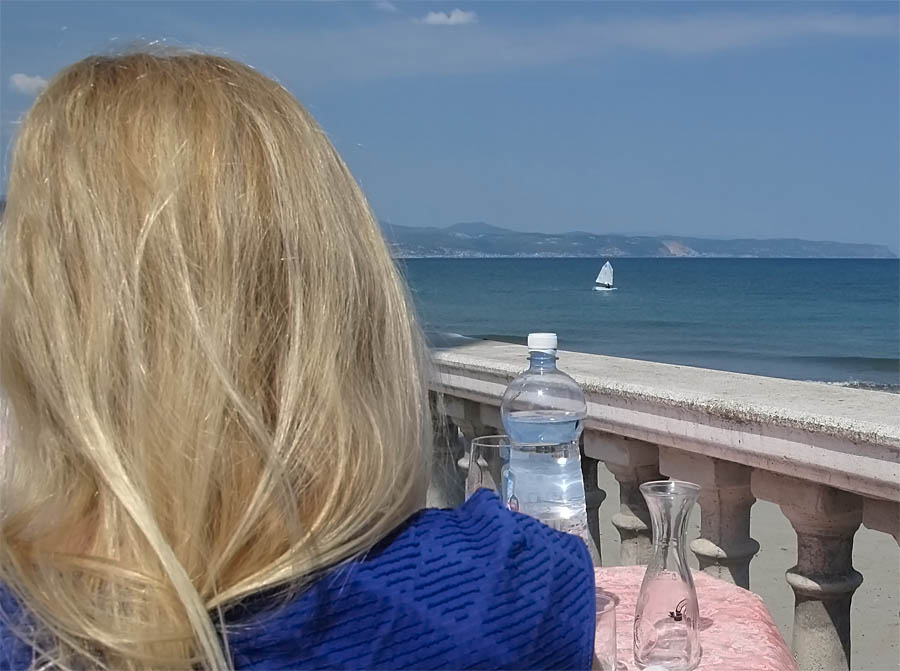
This was taken on the way to Rapallo, just after Alassio, where, as with much of the Italian Riviera coast, it's very hard to find somewhere to park, but once you've done so, there is a great sense of space.
M likes a touch of class, and works hard in one of Nice's best hotels, so I booked a couple of nights in the Grand Hotel Bristol, Rapallo - if it was good enough for Hemingway ... (we'll forget about that other guest, Mussolini - at least for now). 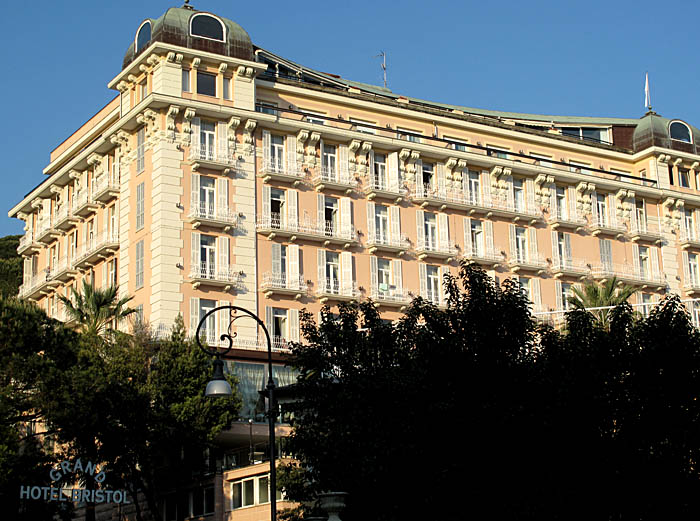
She was very pleased to have a room with this view: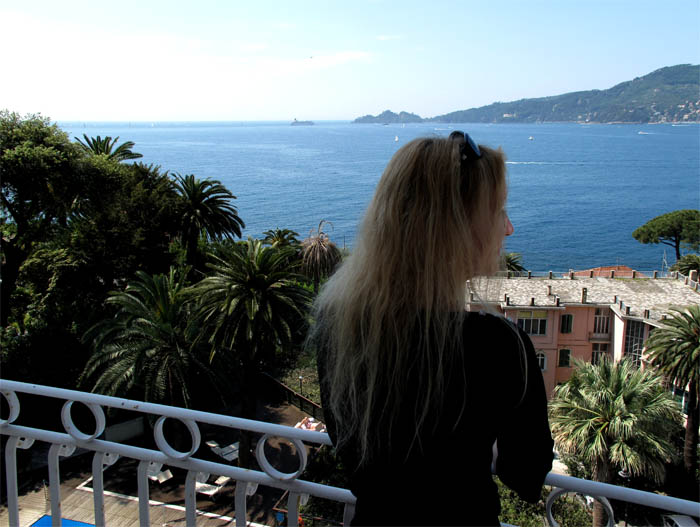

Rapallo Castle: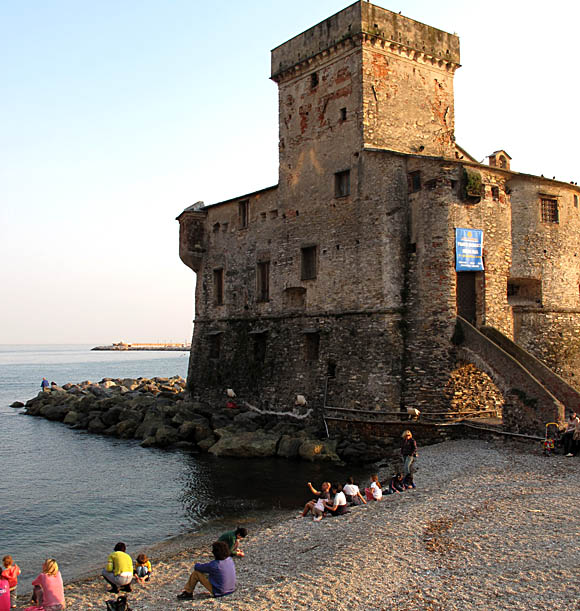
"Rapallo castle is the main symble of the town and it has been declared as a national monument by the Cultural Ministry. It'also erroneously known as mediaeval castle, but it was built in 1551. It's on the Rapallo sea, and it was built after an incursion by the Turkish pirate Dragut in 1549. He kidnapped a hundred of children and maiden who become his slaves on his boats. Therefore, the Genoan Captain Gregorio Roisecco advised Rapallo to build a castle in order to protect the village. Nowadays, the castle is one of the several element of the Ligurian region that deserve to be visited by those people who like the culture."
http://www.globeholidays.net/Europe/Italy/Liguria/Rapallo/Rapallo_Castello1.htm
It now houses occasional exhibitions.
Rapallo has some claim to a connection with Columbus:
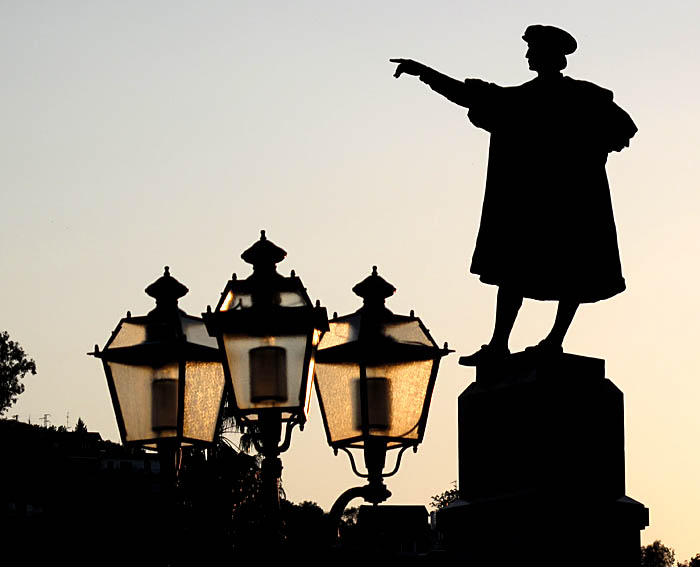
"Go west - to go east"
Cf.: http://www.mahalo.com/The_Day_the_Universe_Changed_Episode_3
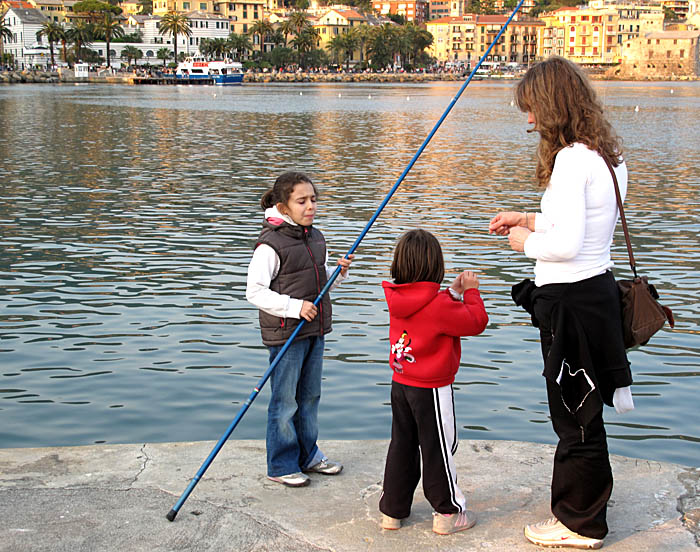
"I'm a boy and I'm telling you this is how you do it."
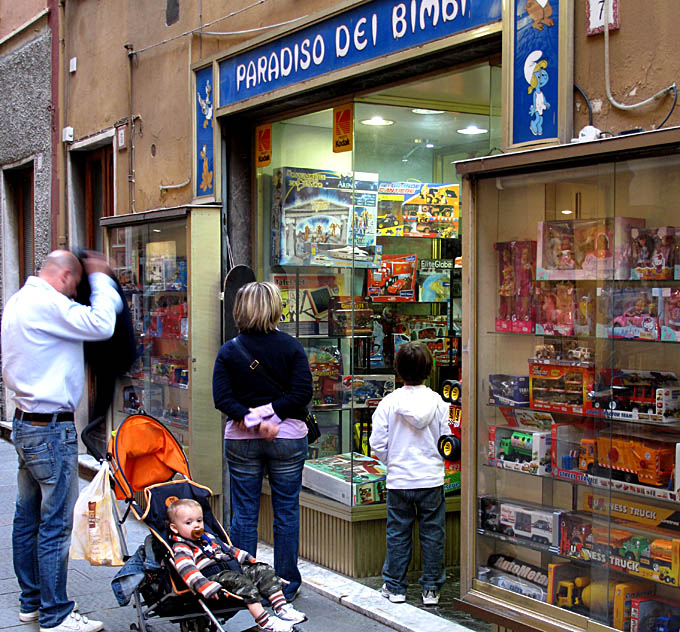
Father: "I can't bear to look." Baby: "Don't they understand there's an economic crisis ? Never mind the toys, just keep my bottle filled."
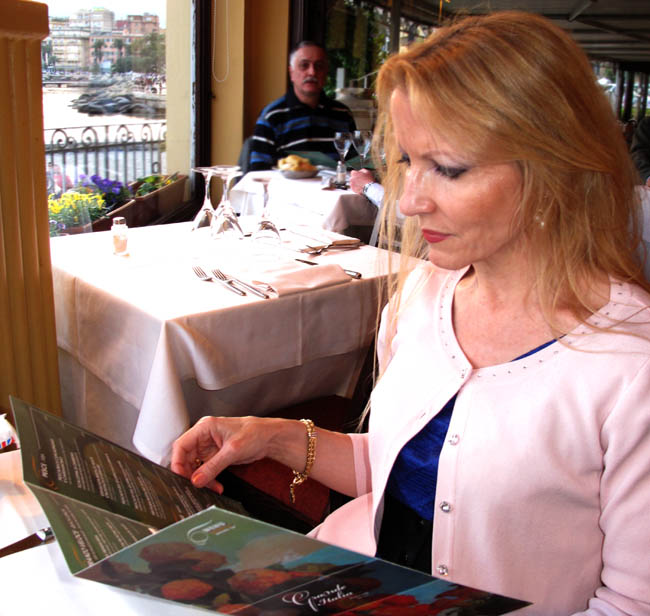
Serious decisions.
Saturday we went to Portofino:
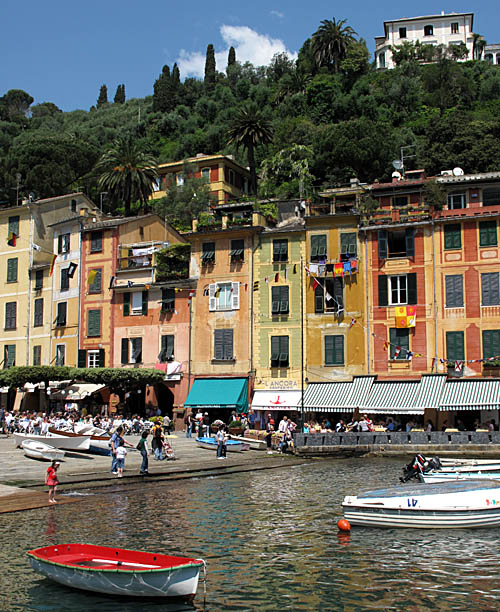
We had hardly stepped ashore when an attractive young woman approached me - with microphone and TV cameraman - asking where I was from and what I thought of Portofino - a bit prematurely. I said I liked all the cafes around the harbour with no traffic and everywhere was like a picture. Maybe I was on Italian TV that evening ! I think perhaps the story was about the effects of the crisis on tourism. In Nice Matin when we got back it was reported that tourism was 15% down in Nice in the first quarter of 2009.
But there was little sign of a lack of tourists that sunny saturday in Portofino:

Though maybe they were spending less:
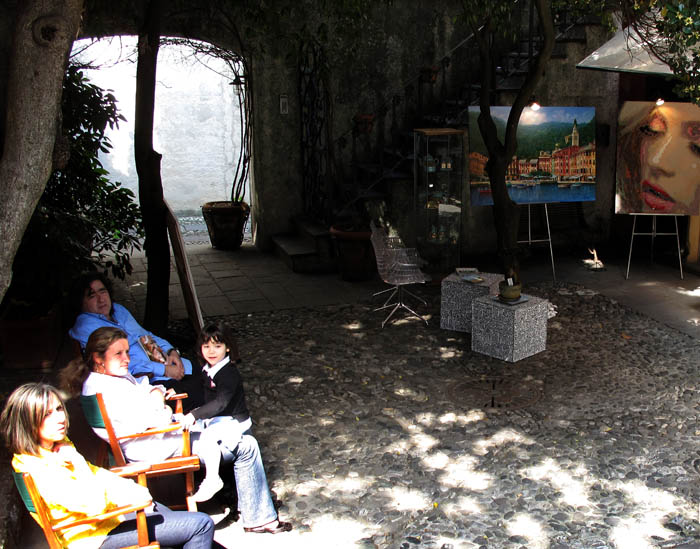
M is always looking for elegant things:
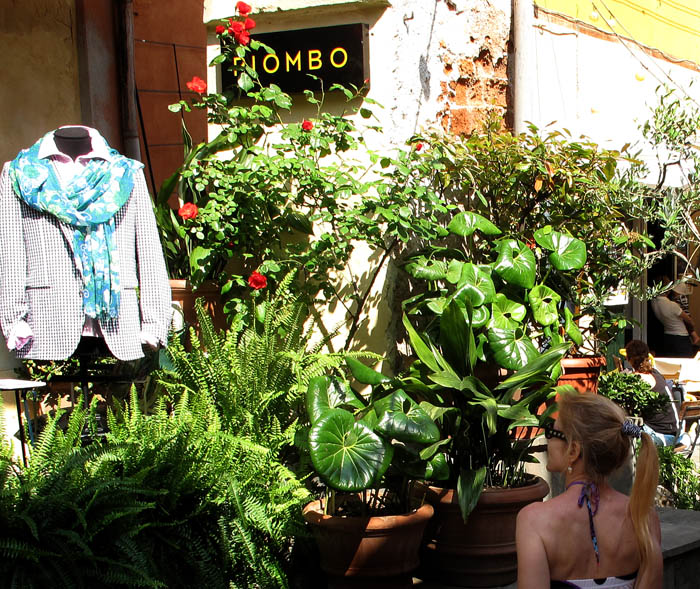
I see things from a slightly different perspective:
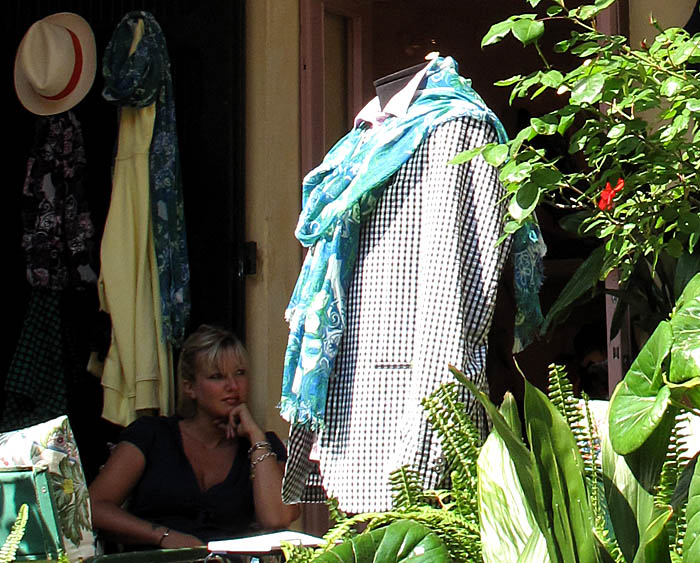
This reminds me of a Magritte crossed with a Mondrian:
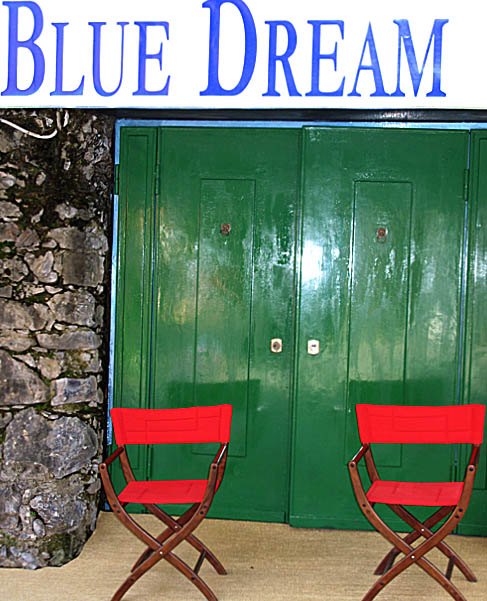
What is the "blue dream" behind the green door?
Midnight, one more night without sleepin`.
Watchin` till the morning comes creepin`.
Green door, what`s that secret you`re keepin`?
There`s an old piano and they play it hot
behind the green door.
Don`t know what they`re doin`, but they laugh alot
behind the gren door.
Wish they`d let me in so i could find out
what`s behind the green door.
I start to worry about having to queue for a long time, or even missing the last boat - which is at 7 pm - when the locals can have a bit of peace:

Mercifully we didn't have to queue for too long. On the way back to Rapallo we passed this great ship:
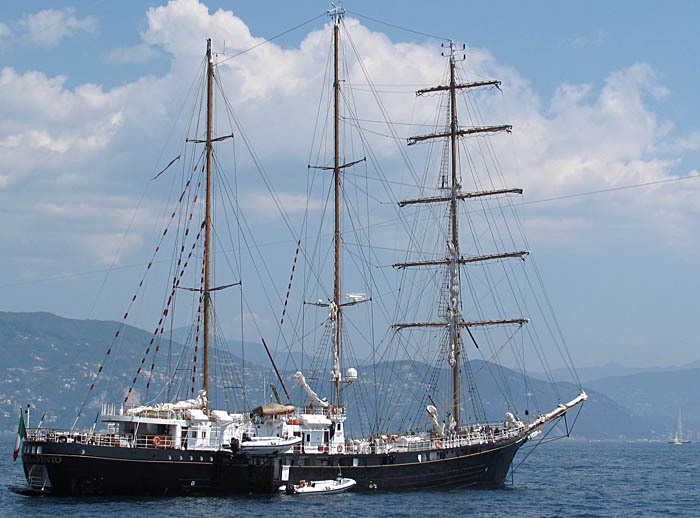
There's a lot more space in Rapallo:
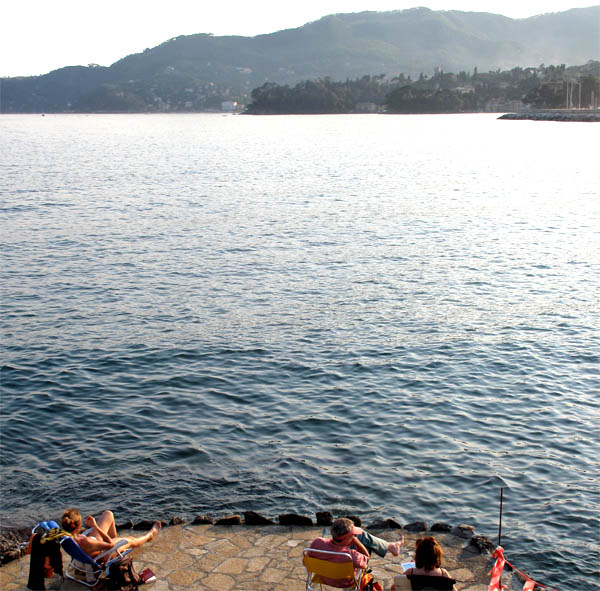
Our stay is too brief and we head back on Sunday:
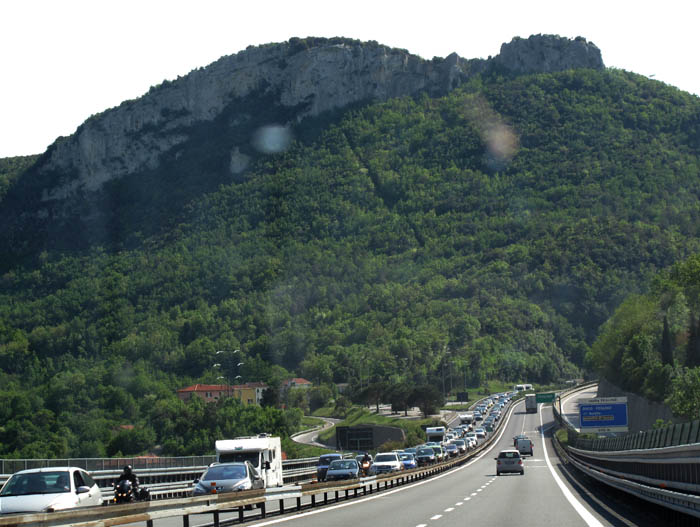
On the way to Rapallo we'd driven on a very clear motorway, past miles of traffic jams in the other direction, what a relief not to have been in that. Now, on the way back, the traffic jams were in the other direction. Maybe the Italians are more enthusiastic about France, than the French are about Italy:
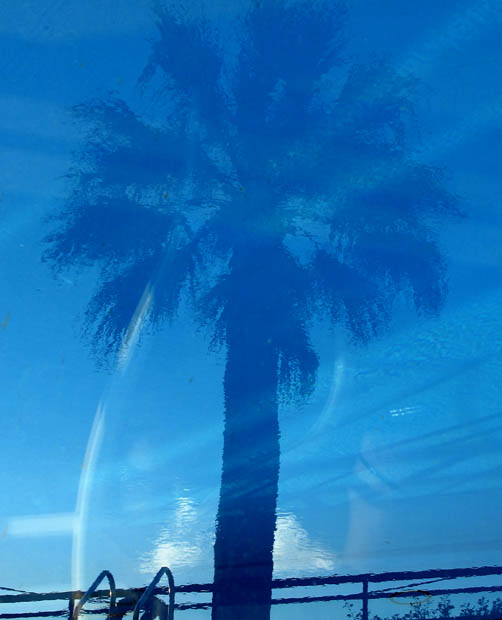
The pool at the Bristol.
We had an easy drive back to Nice - where other palms float against blue.
The Darker side
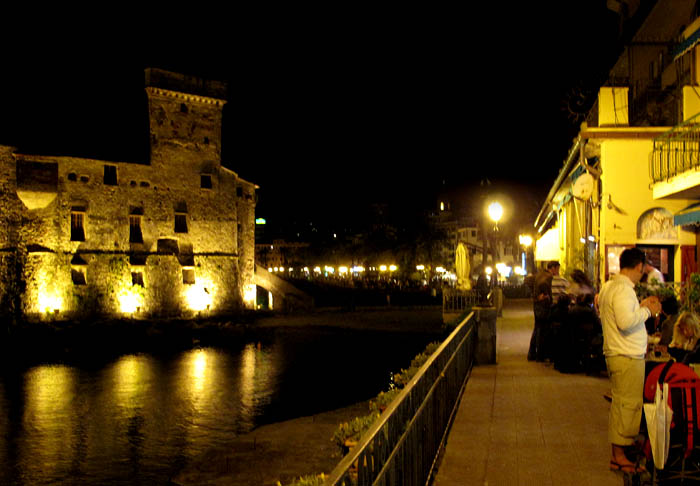
Rapallo's most notorious ex-pat was the poet Ezra Pound; during World War II he did some radio broadcasts and wrote articles supporting Mussolini. He was charged with treason, but judged to be insane and spent years in an asylum in the US before returning to Italy - apparently unrepentent:
... the regret bears on the failure of the ideals not on the ideals themselves, and the Pisan Cantos teem with references to the original utopian project that underpins the allegiance to fascism ... “those words still stand uncancelled, / “Presente!” / and merrda for the monopolists” (LXXVIII 99). The exclamation “Presente!” is at the same time an indirect quote from the subtitle of Canto LXXII (“Presenza”), one of Pound’s few but very violent cantos in Italian, and a direct quote of the Fascist salute to the Duce. Such examples undermine the reading of the post-Pisa cantos in terms of recantation ...
http://erea.revues.org/index364.html
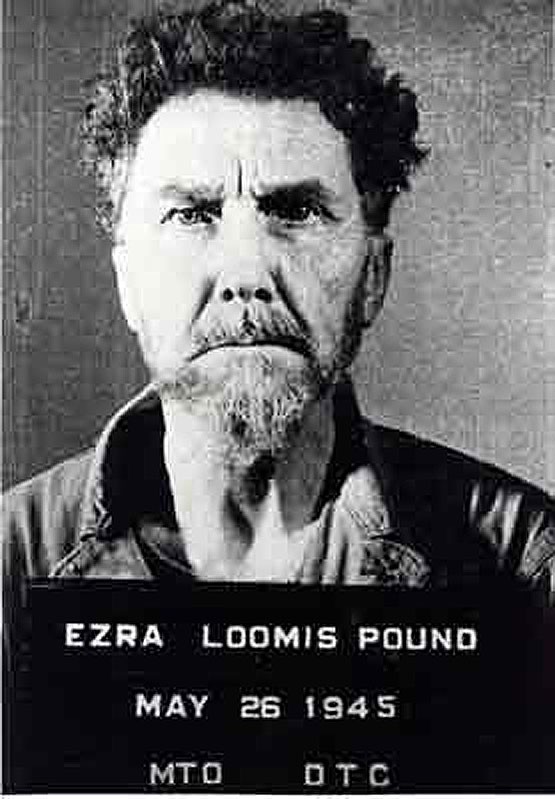
American treatment of prisoners, even a 60 year-old American, paid little attention to Geneva conventions even then; he was held in an open-air cage in Italy for weeks.
The Wikipedia entry about him is something of an apologia (cf. Kazin's very critical views below):
Ezra Weston Loomis Pound (October 30, 1885 – November 1, 1972) was an American expatriate poet, critic and intellectual who was a major figure of the Modernist movement in the first half of the 20th century. He is generally considered the poet most responsible for defining and promoting a modernist aesthetic in poetry...
...
On 10 October 1924, Pound left Paris permanently and moved to Rapallo, Italy. He and Dorothy stayed there briefly, moving on to Sicily, and then returning to settle in Rapallo in January 1925.
...
according to his biographer Humphrey Carpenter "The broadcasts were 'a masterly performance'."[14]. Carpenter wrote "Certainly there were Americans who, in 1941, would have agreed with virtually every word Ezra said at the microphone about the United States Government, the European conflict, and the power of the Jews."[15]. The broadcasts were monitored by the Foreign Broadcast Monitoring Service of the United States government, and transcripts, now stored in the Library of Congress, were made of them. Pound was indicted for treason by the United States government in 1943.
http://en.wikipedia.org/wiki/Ezra_Pound
While his political interventions may have had little effect, some argue that some academics' defense of his poetry had an unfortunate effect on literature and literary criticism:
The Pisan Cantos were awarded the first Library of Congress Bollingen Award by a panel of internationally famous poets in 1949, and have since been surrounded by furor. An admitted fascist under indictment for treason because of wartime radio broadcasts made in support of the Axis cause, Pound was being honored for poems that lamented the passing of fascist and Nazi collaborators, and the general public rose up en masse.
In constructing a defense of Pound, the Bollingen judges and an international array of prominent writers fell back on formalist criteria of poetic value and helped to forge a mandarin, politically conservative "New Criticism" that would dominate the next two decades of literary discourse and ultimately become the primary target of poststructuralist theory ...
http://muse.jhu.edu/login?uri=/journals/modernism-modernity/v002/2.3bush.html
In 1986, Alfred Kazin was quite scathing about Pound's academic defenders and there was a very lively exchange in the New York Review of Books. Kazin responded to those who'd criticised his article:
... The "museum of modern literature" exists in the minds of professors who decade after decade keep annotating every last particle in Pound because they are curators, not critics. I don't accuse them of "playing it safe." They just can't see beyond their noses. The Cantos, for all their occasional beauty, are in my opinion an essentially disordered work. The violent distortions of history, the scatalogical ugliness of Pound's epithets for English literary enemies, Jews, etc., the idolatry of the murderer Musolini as a "twice-crucified" Redeemer eaten by "maggots" (the Italian people) - such violations of truth and art, of all that we have left of civilization in this century of totalitarian horror, mean nothing to curator types.
...
Professor Weiss accuses me of not noting "Pound's profound hatred of war, his powerful attacks on it in Mauberley, the Cantos and elsewhere." Here is a perfect example of the way curators ignore the actual historic circumstances surrounding their sacred object. Pound's horror of the first World War in Mauberley and elsewhere did not extend to the Second, in which he was a propagandist for what Churchill called "the worst crime in human history."
...
http://www.nybooks.com/articles/5012
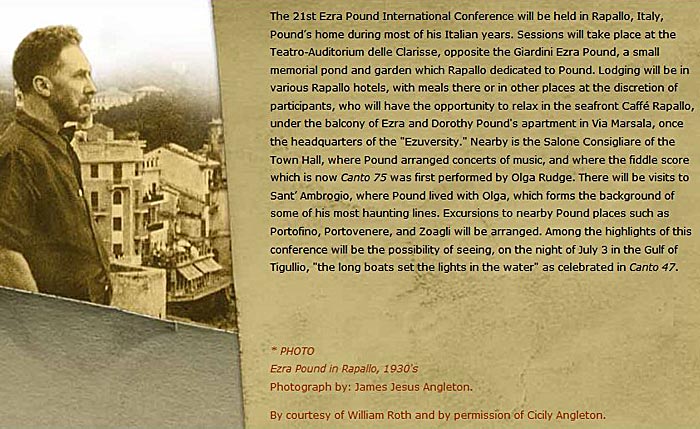
http://www.orgs.muohio.edu/ezrapound/index.php
In searching for images of Pound I was happy to come across this, which actually shows him in Rapallo in the 1930s. It also shows that the "curators," as Kazin described them, go on celebrating Pound, e.g. in the 21st conference on Pound organised by Miami university, not to be confused with the University of Miami, the former, to add to the confusion, is in Oxford, but Oxford, Ohio. The conference was held in Rapallo in 2005, where:
... participants ... will have the opportunity to relax in the seafront Caffé Rapallo, under the balcony of Ezra and Dorothy Pound's apartment in Via Marsala, once the headquarters of the "Ezuversity." ... There will be visits to Sant’ Ambrogio, where Pound lived with Olga, which forms the background of some of his most haunting lines
http://www.orgs.muohio.edu/ezrapound/
No mention, of course, of the more embarrassing "haunting lines" from the wartime broadcasts, e.g.:
Just which of you is free from Jewish influence?
Just which political and business groups are free
from Jew influence, from Jew control?
[broadcast, 19 March 1943]
http://ejournals.library.ualberta.ca/index.php/pi/article/viewFile/1374/919
But then I was stunned to note the credit for the photo of Pound in Rapallo, it was taken by James Jesus Angleton !
Some of you may also be familiar with the name, perhaps the most notorious conspiracy theorist, who, like his poetic hero, Pound, was also alleged to be insane - paranoid; he even suggested that Henry Kissinger was a Soviet agent.
"A wilderness of mirrors"
The phrase "wilderness of mirrors" appears in a 1994 song by the Canadian rock trio Rush. Lyricist/Drummer Neil Peart used the phrase in the song "Double Agent," and cites both Angleton and T. S. Eliot [friend of Pound] in the liner notes as sources of the phrase."
Wikipedia
James Jesus Angleton (December 9, 1917 – May 12, 1987) ... was a long-serving chief of the Central Intelligence Agency's (CIA) counter-intelligence (CI) staff (Associate Deputy Director of Operations for Counter-Intelligence/ADDOCI).
..
Angleton is notable for his long tenure as the CIA's foremost "spy catcher" (as chief of counter-intelligence), but also for being deceived by the Soviet spy, Kim Philby ... Angleton's faith in his abilities was deeply shaken by Philby's success. From that point onward, Angleton was increasingly convinced that CIA was penetrated by other Soviet moles.
A poetry aficionado with known ties to Ezra Pound and T. S. Eliot ... Angleton functioned as principal adviser to successive Directors of the CIA, most notably Allen Dulles and Richard Helms. His excesses as a counter-intelligence czar, arising from extreme paranoia that may have been clinical, had adverse effects on the Agency, especially during the 1970s.
According to former CIA officer Robert Baer: "Angleton was truly a bit of a lunatic. He fancied himself as a serious poet ... In fact, he fairly well destroyed the CIA single-handedly because of his paranoia. He put a security system into place that ensures even today that CIA people work in a bubble, isolated from the way the world works."
...
http://en.wikipedia.org/wiki/James_Jesus_Angleton
Or, as Kazin said of the "curators": "They just can't see beyond their noses."
Unlike Pound, Angleton wasn't charged with treason, not even with illegal acts, yet:
... Colby then demanded Angleton's resignation, after Seymour Hersh told Colby on December 20, 1974, that he was going to publish a story in The New York Times about domestic counter-intelligence activities under Angleton's direction against antiwar protesters and other domestic dissident organizations.
...
These illegal surveillance activities resulted in the generation of 10,000 case files on American citizens ...
ibid
Subverting Italian elections
The consequences of Angleton's activities were far worse for the Italians, but would have been applauded by Pound:
Angleton's personal liaisons with Italian Mafia figures helped the CIA in the immediate period after World War II. Angleton took charge of the CIA's effort to subvert Italian elections to prevent communist and communist-related parties from gaining political leverage in the parliament.
ibid
This was despite the major role which the Italian communists had played in resistance to the Nazis. I don't suppose many left-wing Italians living in Rapallo will be celebrating the work of Pound, still less that of his fan, Angleton.
"Free enterprise painting"
But Angleton and CIA did not confine themselves to politics, at least not in a narrow way, as so often, art was a political tool, particularly effective when its connection to politics was not so evident, but apparently "pure", the expression of individual sensibility and concerned with form - the kind of attitude behind the academic defense of Pound:
Simultaneously, the US did not hesitate to sink huge sums of unaccounted funds into the CIA’s campaign to "culturally" fight communism. This culminated in the Congress for Cultural Freedom, which was rooted into place by 1950. The general idea was to parade art (writing, visual arts, music) that was as antithetical as possible to Stalinist dictums about what art should be. Art was to represent "freedom," a nebulous concept without a context. The idea was that this pro-American freedom was a freedom of the individual, with the emphasis on every-man-for-himself. No political doctrine was going to tell these artists what to do.

"Untitled" Adolph Gottlieb
...
Eva Cockcroft wrote about Abstract Expressionism in Artforum (No. 12) in 1974: "To understand why a particular art movement becomes successful under a given set of historical circumstances requires an examination of the specifics of patronage and the ideological needs of the powerful."
Why was Abstract Expressionist art singled out by the CIA/State Department as an essential weapon of the cultural Cold War? Why did Nelson Rockefeller purchase over 2500 pieces of Abstract Expressionist art and use these paintings to decorate the lobbies of Chase Manhattan banks? And then, why was New York’s Museum of Modern Art so terrifically enthusiastic over this specific art movement?
...
Adolph Gottlieb and Mark Rothko, who went on to become superstars of Abstract Expressionism, led the Federation of Modern Painters and Sculptors fervently against the communist presence in the art world. Even before the tremendous disillusionment that prevailed at the end of the War, the late ’30s brought artists a sense of betrayal by the Soviet Union. They thus took a turn toward Trotskyism, which upheld the belief that art in and of itself was subversive, and should be left free to develop on its own without political restrictions. From there, a new ethos took root: the individual as king.
http://www.slowart.com/articles/cia.htm
" ... the CIA named its biggest front in Europe the Congress for Cultural Freedom. It worked. Soviet art became a laughing stock, and New York became the center of the art world, not Paris, where Picasso, a long-time member of the Communist party and winner of the Stalin Peace Prize (who can forget his doves of peace?), still reigned supreme.
The CIA had stolen the show from Picasso, taking art a step further into a near mystical expression of unfettered human liberty in the spirit of free enterprise. Nelson Rockefeller, whose family created the MoMA, actually referred to Abstract Expressionism as 'free enterprise painting.' ... "
http://www.lewrockwell.com/orig3/cummings3.html
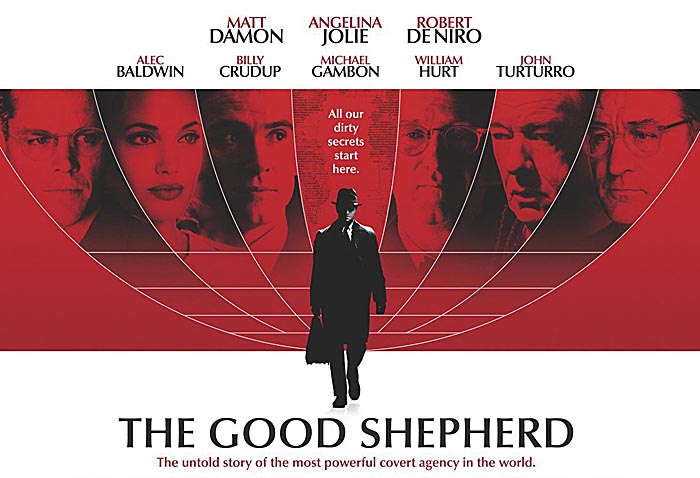
Art catches up with life: "The 2006 film The Good Shepherd is loosely based on Angleton's life and his role in the formation of the CIA." Wikipedia.
The central character is Edward Wilson (a convincingly grey and serious Matt Damon), a literary scholar from a distinguished WASP family, who becomes a member of the world's most exclusive secret society, Skull and Bones, while a student at Yale. Based in part on the famed superspook and counterintelligence expert James Jesus Angleton (though much saner)
...
There's a key moment when a Mafia boss (Joe Pesci), being lured into a plot against Castro, talks about what blacks, Italians, Jews and Irishmen have that gives them a consoling cultural identity. 'But what have you got?' he asks this quiet, complacent WASP. 'The United States of America,' Wilson replies. 'The rest of you are just visiting.'
Philip French
http://www.guardian.co.uk/film/2007/feb/25/robertdeniro.mattdamon
Angleton and Rothko were both working for this elite, but Rothko was not happy with his "superstar" success, which led to a major commission:
In 1958, Rothko was awarded the first of two major mural commissions that proved both rewarding and frustrating. The beverage company Joseph Seagram and Sons had recently completed their new building on Park Avenue, designed by architects Mies Van der Rohe and Philip Johnson. Rothko agreed to provide wall paintings for the building’s restaurant, The Four Seasons.
...
The following June, Rothko and his family again traveled to Europe. While on the SS Independence he disclosed to John Fischer, publisher of Harper's, that his true intention for the Seagram murals was to paint "something that will ruin the appetite of every son-of-a-bitch who ever eats in that room. If the restaurant would refuse to put up my murals, that would be the ultimate compliment. But they won’t. People can stand anything these days."
http://en.wikipedia.org/wiki/Mark_Rothko
Well, the kind of people who could afford his prices could not only stand his paintings, they happily promoted it. His work was bought by a small elite, such as the Rockefellers, the elite to which Angleton belonged and which, through the CIA, was using art to defend its new empire.

It seems that Nietzsche was a major influence on Rothko, but, given the context and his cynicism about it, he lacked Nietzsche's affirmative attitude to life as formulated in "Thus Spake Zarathustra":
Virilio quotes Mark Rothko as stating that he 'trapped the most absolute violence' in his works (2003: 38). Virilio discusses none of Rothko's paintings, much less how Rothko's statement illuminates any particular Rothko canvas. Rather, for Virilio, this statement confirms that Rothko's suicide was an inevitable consequence of Rothko's rejection of human form's representation. By committing suicide, Rothko exercised 'the most nihilistic of freedoms of expression: that of SELF-DESTRUCTION' (Virilio, 2003: 38).
http://www.culturemachine.net/index.php/cm/article/view/211/192
This brings us back to Rapallo:
The following winter I stayed in that charming quiet bay of Rapallo ... it was on these two walks that the whole of Zarathustra occurred to me, and especially Zarathustra himself as a type: rather, he overtook me.
http://www.geocities.com/thenietzschechannel/eh11.htm
In his major work, Zarathustra, Nietzsche fundamentally reworks the idea of eternal recurrence ...
... Nietzsche believed he had created the greatest model of life-affirmation with the eternal recurrence ... Nietzsche wished ... to accord the utmost value to the process of life itself, and in this sense, his formula of recurrence was an experiment with unqualified affirmation.
http://www.temple.edu/gradmag/summer99/berger.htm
But then it's not so difficult to be life-affirming - in places like Rapallo:
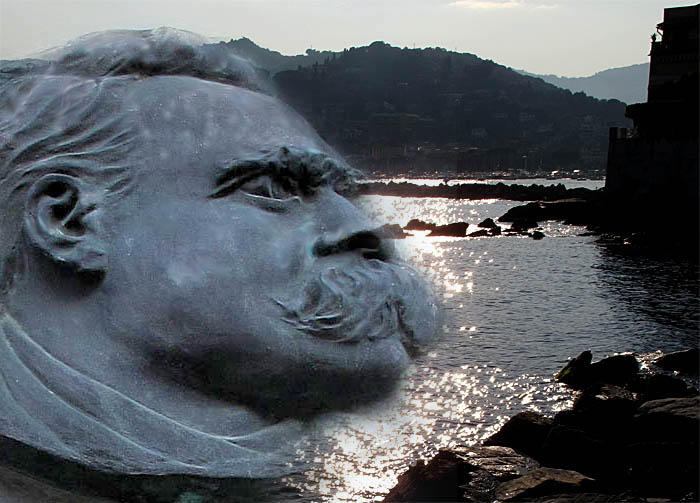
- or Nice, where Nietzsche spent the following six winters and completed Zarathustra:
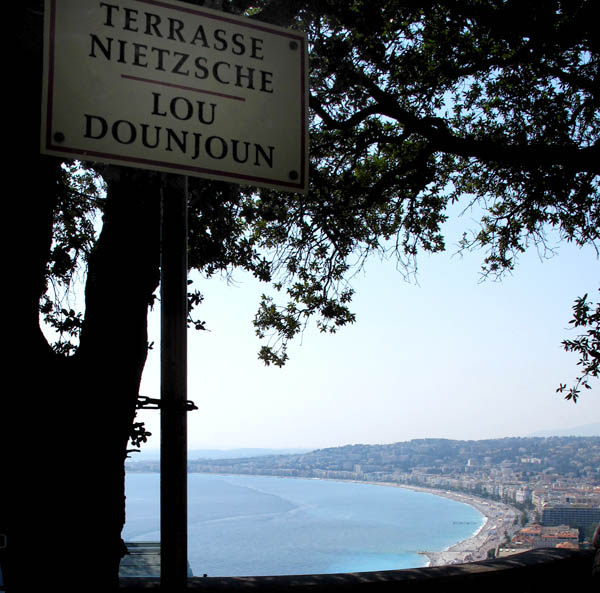
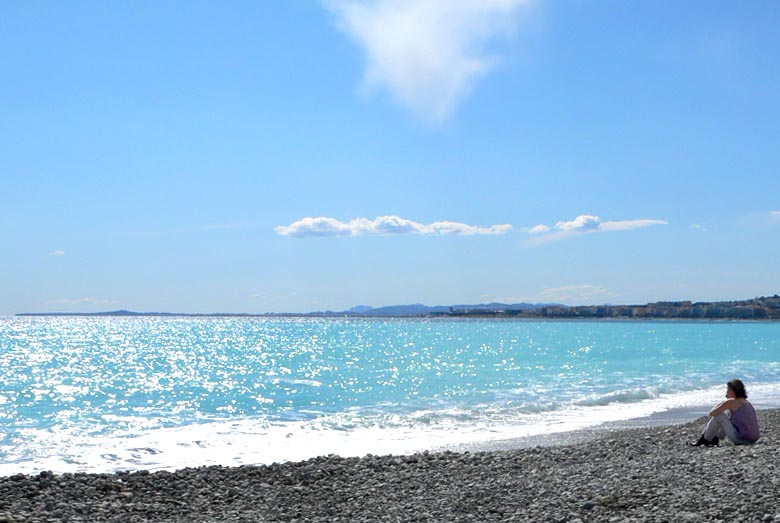
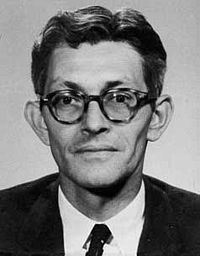
No comments:
Post a Comment